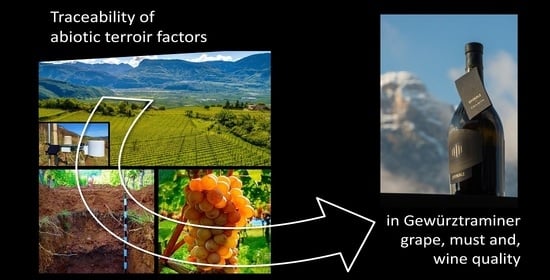Terroir Traceability in Grapes, Musts and Gewürztraminer Wines from the South Tyrol Wine Region
Abstract
1. Introduction
2. Materials and Methods
2.1. Geographical Location
2.2. Geological and Geopedological Settings
2.3. Mineralogy of Soil Sediments
2.4. Agrochemical and Physical Soil Analyses
2.5. Local Climate
2.6. Soil Moisture and Temperature
2.7. Vineyard SRI Index
2.8. Grape, Must and Wine Analyses
2.9. Statistical Analysis
3. Results
3.1. Air Temperature
3.2. Rainfall
3.3. Soil Moisture
3.4. Soil Temperature
3.5. Soil Texture
3.6. Soil and Subsoil Mineralogy
3.6.1. Mineralogical Analysis Using XRD
3.6.2. Chemical Analysis Using XRF Spectrophotometry
3.6.3. ICP-MS Elemental Analysis of Soils
3.7. VGI
3.8. SRI Index
3.9. Chemical and Oenological Analyses
3.9.1. Statistical Analysis Results
3.9.2. Chemical and Oenological Analyses of Grapes, Musts and Wines
4. Discussion
4.1. Water Status
4.2. Air Temperature
4.3. Solar Radiation and Soil Temperature
4.4. Soil Geopedology
4.5. Aromas in Grapes and Wines
4.6. Geographical Traceability of Wine
5. Conclusions
Supplementary Materials
Author Contributions
Funding
Acknowledgments
Conflicts of Interest
References
- van Leeuwen, C. Terroir: The effect of the physical environment on vine growth, grape ripening and wine sensory attributes. Manag. Wine Qual. 2022, 9, 341–393. [Google Scholar] [CrossRef]
- Jackson, D.; Lombard, P. Environmental and management practices affecting grape composition and wine quality—A review. Am. J. Enol. Vitic. 1993, 44, 409–430. [Google Scholar]
- Seguin, G. Ecosystems of the great red wines produced in the maritime climate of Bordeaux. In The Symposium on Maritime Climate Winegrowing; Department of Horticultural Sciences, Cornell University: Ithaca, NY, USA, 1988; pp. 36–53. [Google Scholar]
- Fischer, U.; Bauer, A.; Koschinski, S.; Schmarr, H.-G. Terroir in the Old and New World–what sensory is telling us. Conference Proceeding. In Proceedings of the 16th Australian Wine Industry Technical Conference, Adelaide, Australia, 24–28 July 2016; pp. 30–35, ISBN 978-0-9870480-9-7. [Google Scholar]
- Ferretti, C.G. Relationship between the geology, soil assessment, and terroir of Gewürtztraminer vineyards: A case study in the Dolomites of northern Italy. CATENA 2019, 179, 74–84. [Google Scholar] [CrossRef]
- Van Leeuwen, C.; Seguin, G. The concept of terroir in viticulture. J. Wine Res. 2006, 17, 1–10. [Google Scholar] [CrossRef]
- Ferretti, C. Topoclimate and wine quality: Results of research on the Gewürztraminer grape variety in South Tyrol, northern Italy. OENO One Vine Wine J. 2021, 55, 313–335. [Google Scholar] [CrossRef]
- Darriet, P.; Thibon, C.; Dubourdieu, D. Aroma and aroma precursors in grape berry. Biochem. Grape Berry 2012, 2012, 111–136. [Google Scholar] [CrossRef]
- Van Leeuwen, C.; Roby, J.-P.; De Rességuier, L. Soil-related terroir factors: A review. OENO One 2018, 52, 173–188. [Google Scholar] [CrossRef]
- De Rességuier, L.; Mary, S.; Le Roux, R.; Petitjean, T.; Quénol, H.; Van Leeuwen, C. Temperature Variability at Local Scale in the Bordeaux Area. Relations with Environmental Factors and Impact on Vine Phenology. Front. Plant Sci. 2020, 11, 515. [Google Scholar] [CrossRef]
- Duchêne, E.; Schneider, C. Grapevine and climatic change: A glance at the situation in Alsace. Agron. For. Sustain. Dev. 2005, 25, 93–99. [Google Scholar] [CrossRef]
- Yamane, T.; Jeong, S.; Goto-Yamamoto, N.; Koshita, Y.; Kobayashi, S. Effects of Temperature on Anthocyanin Biosynthesis in Grape Berry Skins. Am. J. Enol. Vitic. 2006, 57, 54–59. [Google Scholar]
- Parker, A.K.; Garcia De Cortazar-Atauri, I.; Van Leeuwen, C.; Chuine, I. General phenological model to characterise the timing of flowering and veraison of Vitis vinifera L. Aust. J. Grape Wine Res. 2011, 17, 206–216. [Google Scholar] [CrossRef]
- Zufferey, V.; Murisier, F.; Schultz, H.R. A model analysis of the photosynthetic response of Vitis vinifera L. cvs Riesling and Chasselas leaves in the field: I. Interaction of age, light and temperature. VITIS 2000, 39, 19–26. [Google Scholar]
- Spayd, S.E.; Tarara, J.M.; Mee, D.L.; Ferguson, J.C. Separation of Sunlight and Temperature Effects on the Composition of Vitis vinifera cv. Merlot Berries. Am. J. Enol. Vitic. 2002, 53, 171–182. Available online: https://www.ars.usda.gov/ARSUserFiles/5550/2002_Spayd_AJEV_53_171-182.pdf (accessed on 22 May 2022).
- Alonso, R.; Berli, F.; Fontana, A.; Piccoli, P.; Bottini, R. Malbec grape (Vitis vinifera L.) responses to the environment: Berry phenolics as influenced by solar UV-B, water deficit and sprayed abscisic acid. Plant Physiol. Biochem. 2016, 109, 84–90. [Google Scholar] [CrossRef]
- Pellegrino, A.; Lebon, E.; Simonneau, T.; Wery, J. Towards a simple indicator of water stress in grapevine (Vitis vinifera L.) based on the differential sensitivities of vegetative growth components. Aust. J. Grape Wine Res. 2005, 11, 306–315. [Google Scholar] [CrossRef]
- Matthews, M.A.; Anderson, M.M. Fruit ripening in Vitis vinifera L.: Responses to seasonal water deficits. Am. J. Enol. Vitic. 1988, 39, 313–320. [Google Scholar]
- Van Leeuwen, C.; Trégoat, O.; Choné, X.; Bois, B.; Pernet, D.; Gaudillère, J.-P. Vine water status is a key factor in grape ripening and vintage quality for red Bordeaux wine. How can it be assessed for vineyard management purposes? J. Int. Sci. Vigne Vin 2009, 43, 121–134. [Google Scholar] [CrossRef]
- Choné, X.; van Leeuwen, C.; Cherry, P.; Ribereau-Gayon, P. Terroir influence on water status and nitrogen status of non-irrigated Cabernet Sauvignon (Vitis vinifera): Vegetative development, must and wine composition. S. Afr. J. Enol. Vitic. 2001, 22, 8–15. [Google Scholar]
- White, R.E. The Value of Soil Knowledge in Understanding Wine Terroir. Front. Environ. Sci. 2020, 8, 12. [Google Scholar] [CrossRef]
- Seguin, G. L’alimentation en eau de la vigne dans des sols du Haut-Médoc. J. Int. Sci. Vigne Vin 1969, 3, 93–141. [Google Scholar] [CrossRef]
- Bodin, F.; Morlat, R. Characterization of Viticultural Terroirs using a Simple Field Model Based on Soil Depth I. Validation of the Water Supply Regime, Phenology and Vine Vigour, in the Anjou Vineyard (France). Plant Soil 2006, 281, 37–54. [Google Scholar] [CrossRef]
- Morlat, R.; Bodin, F. Characterization of Viticultural Terroirs using a Simple Field Model Based on Soil Depth—II. Validation of the Grape Yield and Berry Quality in the Anjou Vineyard (France). Plant Soil 2006, 281, 55–69. [Google Scholar] [CrossRef]
- Renouf, V.; Trégoat, O.; Roby, J.-P.; van Leeuwen, C. Soils, rootstocks and grapevine varieties in prestigious Bordeaux vineyards and their impact on yield and quality. J. Int. Sci. Vigne Vin 2010, 44, 127. [Google Scholar] [CrossRef]
- Ferretti, C.G. A new geographical classification for vineyards tested in the South Tyrol wine region, northern Italy, on Pinot Noir and Sauvignon Blanc wines. Ecol. Indic. 2020, 108, 105737. [Google Scholar] [CrossRef]
- Pedri, U.; Pertoll, G. Der Einfluss des Standortes auf die sensorischen Eigenschaften der Weine verschiedener Rebsorten. Obst. Weinbau 2012, 50, 130–133. [Google Scholar]
- Dohrmann, R.; Kaufhold, S. Three New, Quick CEC Methods for Determining the Amounts of Exchangeable Calcium Cations in Calcareous Clays. Clays Clay Miner. 2009, 57, 338–352. [Google Scholar] [CrossRef]
- Ferretti, C.G.; Cruciani, G. Vineyards and clay minerals: Multi-technique analytical approach and correlations with soil properties. In Proceedings of the 90th Congress of SGI, Session Geology, Food and Health, Trieste, Italy, 14–16 September 2021. [Google Scholar]
- Weil, R.R.; Brady, N.C. The Nature and Properties of Soils; Pearson: Columbus, OH, USA, 2016; ISBN 978-0-13-325448-8. [Google Scholar]
- Van Leeuwen, C.; Barbe, J.-C.; Darriet, P.; Geffroy, O.; Gomès, E.; Guillaumie, S.; Helwi, P.; Laboyrie, J.; Lytra, G.; Le Menn, N.; et al. Recent advancements in understanding the terroir effect on aromas in grapes and wines. OENO One 2020, 54, 985–1006. [Google Scholar] [CrossRef]
- Fischer, M.; Rudmann-Maurer, K.; Weyand, A.; Stöcklin, J. Agricultural Land Use and Biodiversity in 572 the Alps. Mt. Res. Dev. 2008, 28, 148–155. [Google Scholar] [CrossRef]
- Sitzia, T.; Trentanovi, G. Maggengo meadow patches enclosed by forests in the Italian Alps: Evidence 624 of landscape legacy on plant diversity. Biodivers. Conserv. 2011, 20, 945–961. [Google Scholar] [CrossRef]
- Hu, A.; Wang, J.; Sun, H.; Niu, B.; Si, G.; Wang, J.; Yeh, C.-F.; Zhu, X.; Lu, X.; Zhou, J.; et al. Mountain biodiversity and ecosystem functions: Interplay between geology and contemporary environments. ISME J. 2020, 14, 931–944. [Google Scholar] [CrossRef]
- Nicolini, G.; Malossini, U.; Tonidandel, L.; Roman, T. Differenze clonali nella dotazione di precursori dei tioli varietali in Gewürztraminer. Infowine Riv. Di Vitic. Ed Enol. 2019, 6, 1–9. [Google Scholar]
- Dirninger, N.; Duc, D.; Dumas, V.; Asselin, C.; Schäffer, A. Qualité des Wine quality and “terroirs”–influence of environmental characteristics on the Gewürztraminer flavor profile. Sci. Aliment 1998, 18, 193–209. [Google Scholar]
- Carlin, S.; Lotti, C.; Correggi, L.; Mattivi, F.; Arapitsas, P.; Vrhovšek, U. Measurement of the Effect of Accelerated Aging on the Aromatic Compounds of Gewürztraminer and Teroldego Wines, Using a SPE-GC-MS/MS Protocol. Metabolites 2022, 12, 180. [Google Scholar] [CrossRef] [PubMed]
- Antalick, G.; Šuklje, K.; Blackman, J.W.; Schmidtke, L.M.; Deloire, A. Performing sequential harvests based on berry sugar accumulation (mg/berry) to obtain specific wine sensory profiles. OENO One 2021, 55, 131–146. [Google Scholar] [CrossRef]
- Voica, C.; Dehelean, A.; Pamula, A. Method validation for determination of heavy metals in wine and slightly alcoholic beverages by ICP-MS. J. Phys. Conf. Ser. 2009, 182, 012036. [Google Scholar] [CrossRef]
- Geana, I.; Iordache, A.; Ionete, R.; Marinescu, A.; Ranca, A.; Culea, M. Geographical origin identification of Romanian wines by ICP-MS elemental analysis. Food Chem. 2013, 138, 1125–1134. [Google Scholar] [CrossRef]
- Costantini, E.A.C. La componente pedologica del terroir. Italus Hortus 2015, 22, 15–30. [Google Scholar]
- Grainger, C.; Yeh, A.; Byer, S.; Hjelmeland, A.; Lima, M.M.; Runnebaum, R.C. Vineyard site impact on the elemental composition of Pinot noir wines. Food Chem. 2020, 334, 127386. [Google Scholar] [CrossRef]
- Palade, M.; Popa, M.E. Wine traceability and authenticity—A literature review. Scientific Bulletin. Ser. F Biotechnol. 2014, 18, 226–233. [Google Scholar]
- Durante, C.; Bertacchini, L.; Bontempo, L.; Camin, F.; Manzini, D.; Lambertini, P.; Marchetti, A.; Paolini, M. From soil to grape and wine: Variation of light and heavy elements isotope ratios. Food Chem. 2016, 210, 648–659. [Google Scholar] [CrossRef]
- Ferretti, C.G.; Poggesi, S.; Duley, G.; Imperiale, S.; Ding, Y.; Ksenia, M.; Scampicchio, M.; Boselli, E. How distinctive are single vineyard Gewürztraminer musts and wines from Alto Adige (Italy) based on untargeted analysis, sensory profiling, and chemometric elaboration? In Proceedings of the Terclim 2022–XIVth International Terroir Congress, Bordeaux, France, 3–8 July 2022. [Google Scholar]
- Kaufmann, E.G. Concepts and methods of high-resolution event in stratigraphy. Ann. Rev. Earth Planet. Sci. 1988, 12, 605–654. [Google Scholar] [CrossRef]
- Singer, M.J. Basic Principles of Pedology. Ref. Modul. Earth Syst. Environ. Sci. 2015. [Google Scholar] [CrossRef]
- Conde, C.; Silva, P.; Fontes, N.; Dias, A.C.P.; Tavares, R.M.; Sousa, J.M.; Agasse, A.; Delrot, S.; Gerós, H. Biochemical changes throughout grape berry development and fruit and wine quality. Glob. Sci. Book 2007, 1, 1–22. [Google Scholar]
- Violante, P. Metodi di analisi chimica del suolo. In Metodi Analitici Per L’agricoltura; Franco Angeli: Milano, Italy, 2000; p. 536. ISBN 8846422406. [Google Scholar]
- DIN ISO 17892-4; Geotechnical Investigation and Testing-Laboratory Testing of Soil-Part 4: Determination of Particle Size Distribution. German Version EN ISO; ISO: Geneva, Switzerland, 2017; 44p.
- International Organisation of Vine and Wine. Compendium of International Methods of Wine and Must Analysis; OIV: Paris, France, 2020; ISBN 978-2-85038-016-7. [Google Scholar]
- Versini, G.; Dalla Serra, A.; Scienza, A.; Barchetti, P. Particolarità compositive dell’uva e del vino Traminer aromatico. Atti del Simposio: Traminer aromatico. Ed. Ass. Agr. Prov. Aut. Bolzano 1990, 1, 59–71. [Google Scholar]
- Marais, J.; Rapp, A. The Selection of Aroma-Rich Clones of Vitis vinifera L. cv. Gewürztraminer and Weisser Riesling by Means of Terpene Analyses. South Afr. J. Enol. Vitic. 1991, 12, 51–56. [Google Scholar] [CrossRef][Green Version]
- Román, T.; Tonidandel, T.; Larcher, R.; Celotti, E.; Nicolini, G. Importance of polyfunctional thiols on semi-industrial Gewürztraminer wines and the correlation to technological treatments. Eur. Food Res. Technol. 2017, 244, 379–386. [Google Scholar] [CrossRef]
- Heiri, O.; Lotter, A.F.; Lemcke, G. Loss on ignition as a method for estimating organic and carbonate content in sediments: Reproducibility and comparability of results. J. Paleolimnol. 2001, 25, 101–110. [Google Scholar] [CrossRef]
- Vukovic, M.; Soro, A. Determination of Hydraulic Conductivity of Porous Media from Grain-Size Composition; Water Resources Publications: Englewood, CO, USA, 1992; p. 54. ISBN 978-0918334770. [Google Scholar]
- Borsato, A.; Cucato, M. Erläuterungen zur geologischen Karte von Italien im Maßstab 1:50.000. Blatt Mezzolombardo. Stratigr. Quartären Ablagerungen 2012, 1, 103–171. Available online: https://www.isprambiente.gov.it/Media/carg/note_illustrative/13_Merano_Ted.pdf (accessed on 14 January 2021).
- Nicolini, G.; Larcher, R.; Bertoldi, D.; Puecher, C. Fenoli Volatili dei Vini: Metodi Rapidi per i Controlli Enochimici di Processo. L’enologo, 01/02 2008. 2008, pp. 89–93. Available online: https://www.assoenologi.it/wp-content/uploads/2019/02/fenoli_volatili__vini_genn_febb2008.pdf (accessed on 10 March 2022).
- Baffi, C.; Trincherini, P.R. Food traceability using the Sr-87/Sr-86 isotopic ratio mass spectrometry. Eur. Food Res. Technol. 2016, 242, 1411–1439. [Google Scholar] [CrossRef]
- Bora, F.D.; Donici, A.; Rusu, T.; Bunea, A.; Popescu, D.; Bunea, C.I. Elemental Profile and 207Pb/206Pb, 208Pb/206Pb, 204Pb/206Pb, 87Sr/86Sr Isotope Ratio as Fingerprints for Geographical Traceability of Romanian Wines. Not. Bot. Horti Agrobot. Cluj-Napoca 2017, 46, 223–239. [Google Scholar] [CrossRef]
- Gabel, B. Wine origin authentication linked to terroir–wine fingerprint. BIO Web Conf. 2019, 15, 02033. [Google Scholar] [CrossRef]
- Conticelli, S. Tracciabilità Geografica dei Vini Italiani e Geologia: Correlazione tra 87Sr/86Sr in vini e mosti e caratteristiche geochimiche e geologiche del substrato delle vigne di produzione (GeoWine). In Alimentazioni, Sostenibilità e Multiculturalità. Azioni, Riflessioni e Temi di Ricerca, progetto Axìa; Arcipelago Edizioni; Università e Impresa per la Ricerca: Firenze, Italy, 2009; pp. 273–274. [Google Scholar]
- Lin, J.; Massonnet, M.; Cantu, D. The genetic basis of grape and wine aroma. Hortic. Res. 2019, 6, 1–24. [Google Scholar] [CrossRef] [PubMed]
- Swiegers, J.; Bartowsky, E.; Henschke, P.; Pretorius, I. Yeast and bacterial modulation of wine aroma and flavour. Aust. J. Grape Wine Res. 2005, 11, 139–173. [Google Scholar] [CrossRef]
- Duffková, R. Influence of soil physical properties and terrain relief on actual evapotranspiration in the catchment with prevailing arable land determined by energy balance and bowen ratio. In Evapotranspiration—An Overview; Alexandris, S.G., Ed.; IntechOpen: London, UK, 2013; Volume 10, 282p. [Google Scholar] [CrossRef][Green Version]
- Tesic, D.; Woolley, D.; Hewett, E.; Martin, D. Environmental effects on cv Cabernet Sauvignon (Vitis vinifera L.) grown in Hawke’s Bay, New Zealand.: 2. Development of a site index. Aust. J. Grape Wine Res. 2002, 8, 27–35. [Google Scholar] [CrossRef]
- Weaver, R.J.; McCune, S.B. Influence of Light on Color Development in Vitis Vinifera Grapes. Am. J. Enol. Vitic. 1960, 11, 179–184. [Google Scholar]
- Palliotti, A.; Tombesi, S.; Silvestroni, O.; Lanari, V.; Gatti, M.; Poni, S. Changes in vineyard establishment and canopy management urged by earlier climate-related grape ripening: A review. Sci. Hortic. 2014, 178, 43–54. [Google Scholar] [CrossRef]
- Gaiotti, F.; Pastore, C.; Filippetti, I.; Lovat, L.; Belfiore, N.; Tomasi, D. Low night temperature at veraison enhances the accumulation of anthocyanins in Corvina grapes (Vitis Vinifera L.). Sci. Rep. 2018, 8, 8719. [Google Scholar] [CrossRef] [PubMed]
- Tarara, J.M.; Lee, J.; Spayd, S.E.; Scagel, C.F. Berry Temperature and Solar Radiation Alter Acylation, Proportion, and Concentration of Anthocyanin in Merlot Grapes. Am. J. Enol. Vitic. 2008, 59, 235–247. [Google Scholar]
- Tarara, J.M.; Lee, J. An Introduction to Environmental Influences on Ripening in Grapes: Focus on Wine Grapes and Phenolics; Oregon State University Extension Publications: Corvallis, Oregon, 2011; Available online: https://grapes.extension.org/an-introduction-to-environmental-influences-on-ripening-in-grapes-focus-on-wine-grapes-and-phenolics/ (accessed on 12 September 2021).
- Verdenal, T.; Dienes-Nagy, Á.; Spangenberg, J.E.; Zufferey, V.; Spring, J.-L.; Viret, O.; Marin-Carbonne, J.; Van Leeuwen, C. Understanding and managing nitrogen nutrition in grapevine: A review. OENO One 2021, 55, 1–43. [Google Scholar] [CrossRef]
- Mirás-Avalos, J.M.; Bouzas-Cid, Y.; Trigo-Córdoba, E.; Orriols, I.; Falqué, E. Amino Acid Profiles to Differentiate White Wines from Three Autochtonous Galician Varieties. Foods 2020, 9, 114. [Google Scholar] [CrossRef] [PubMed]
- Hervé, A. Aging on lees and their alternatives: Impact on wine. Food Science, Technology and Nutrition. Manag. Wine Qual. (Second Ed.) 2022, 2, 213–244. [Google Scholar] [CrossRef]
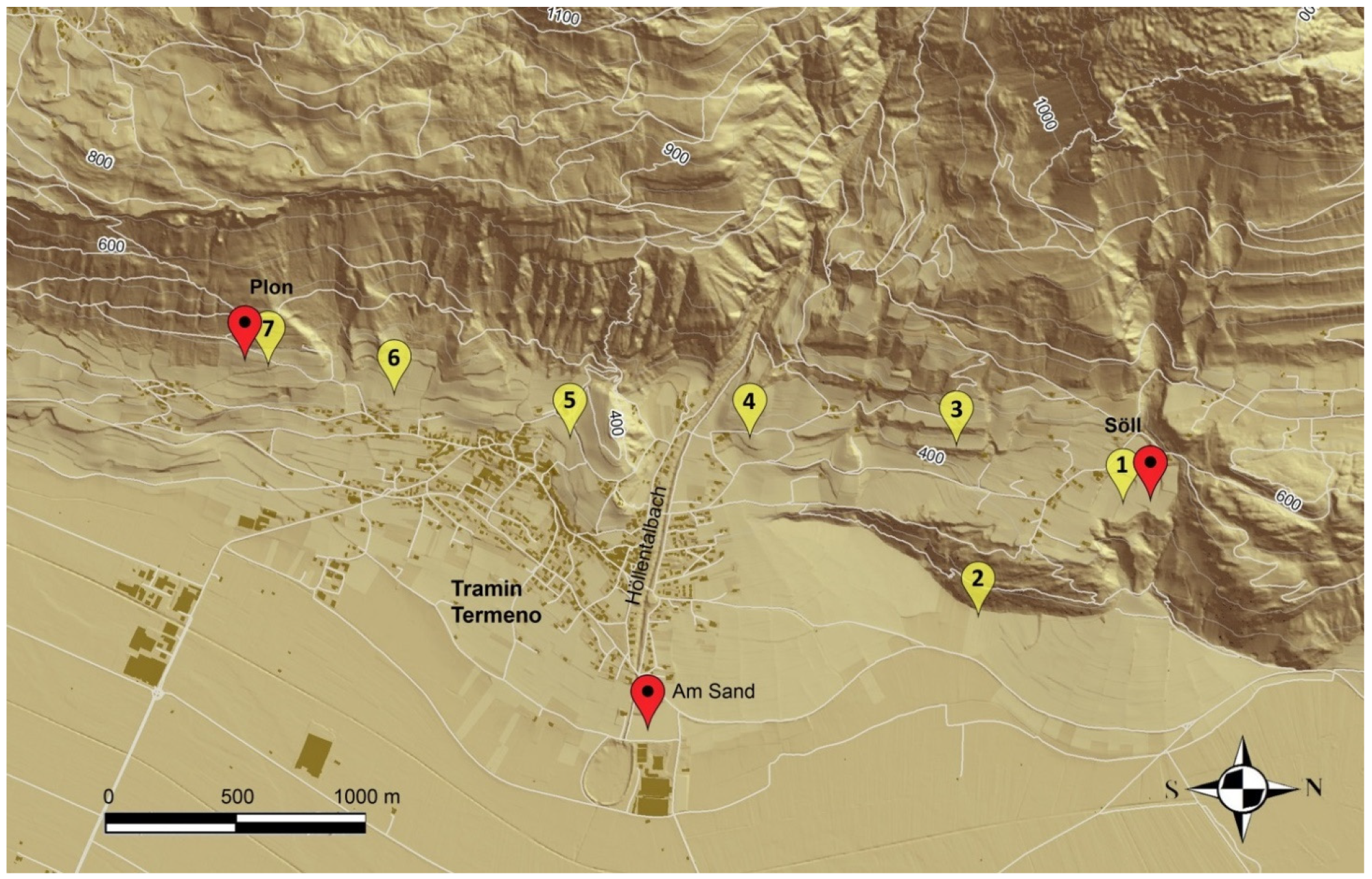


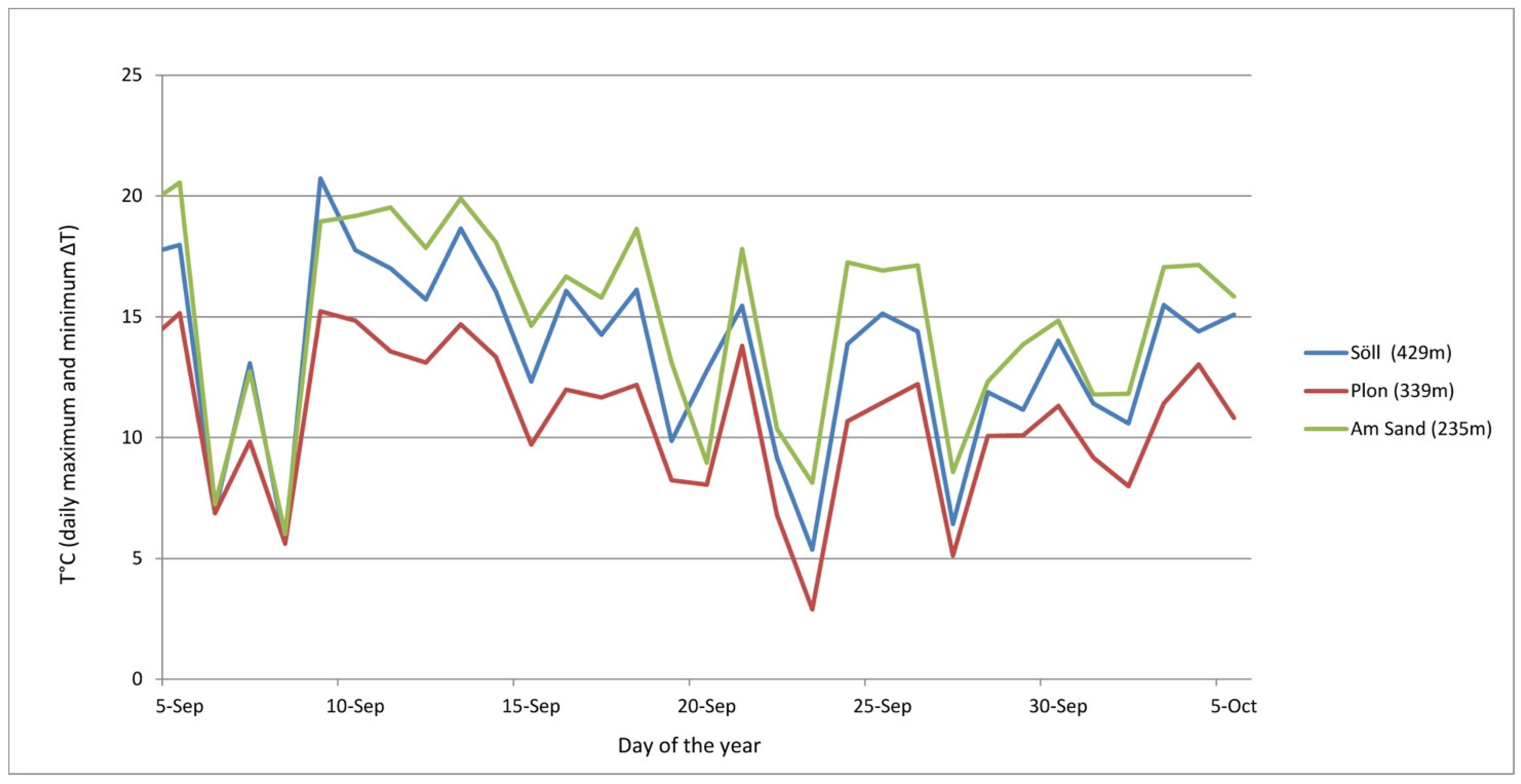


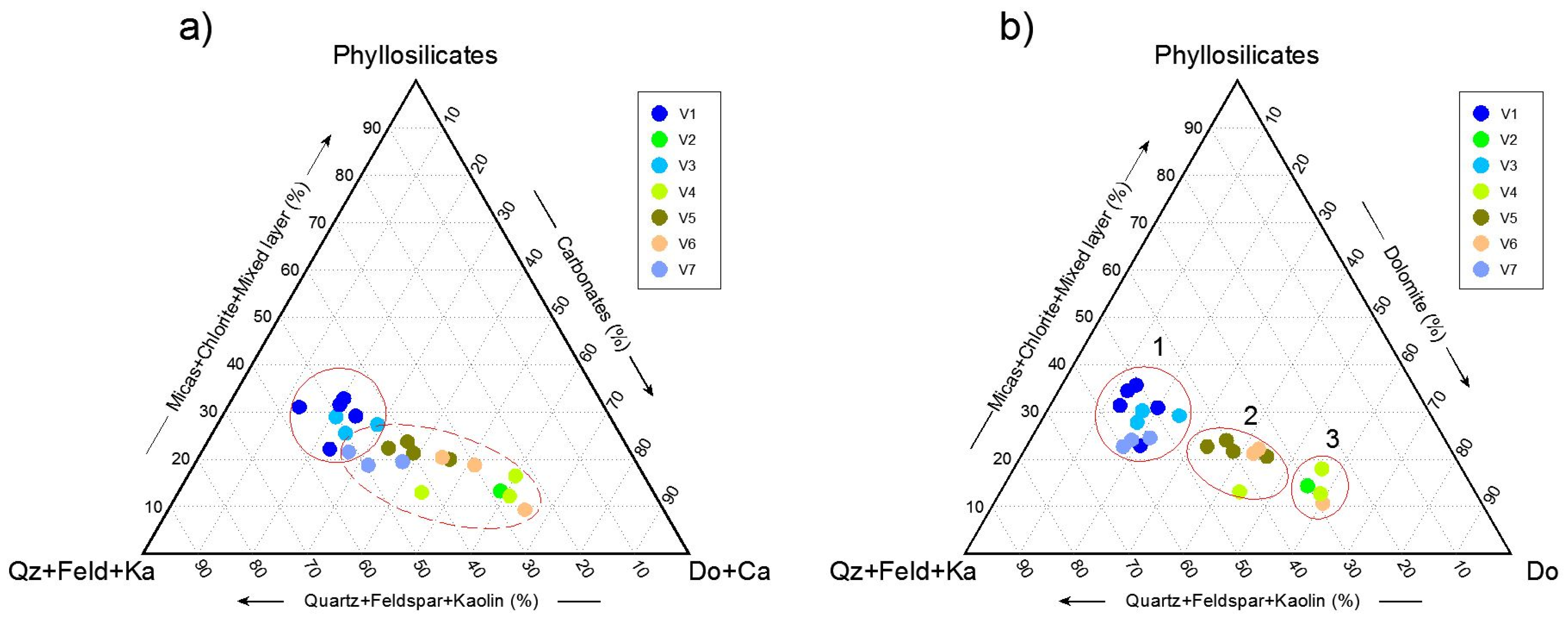

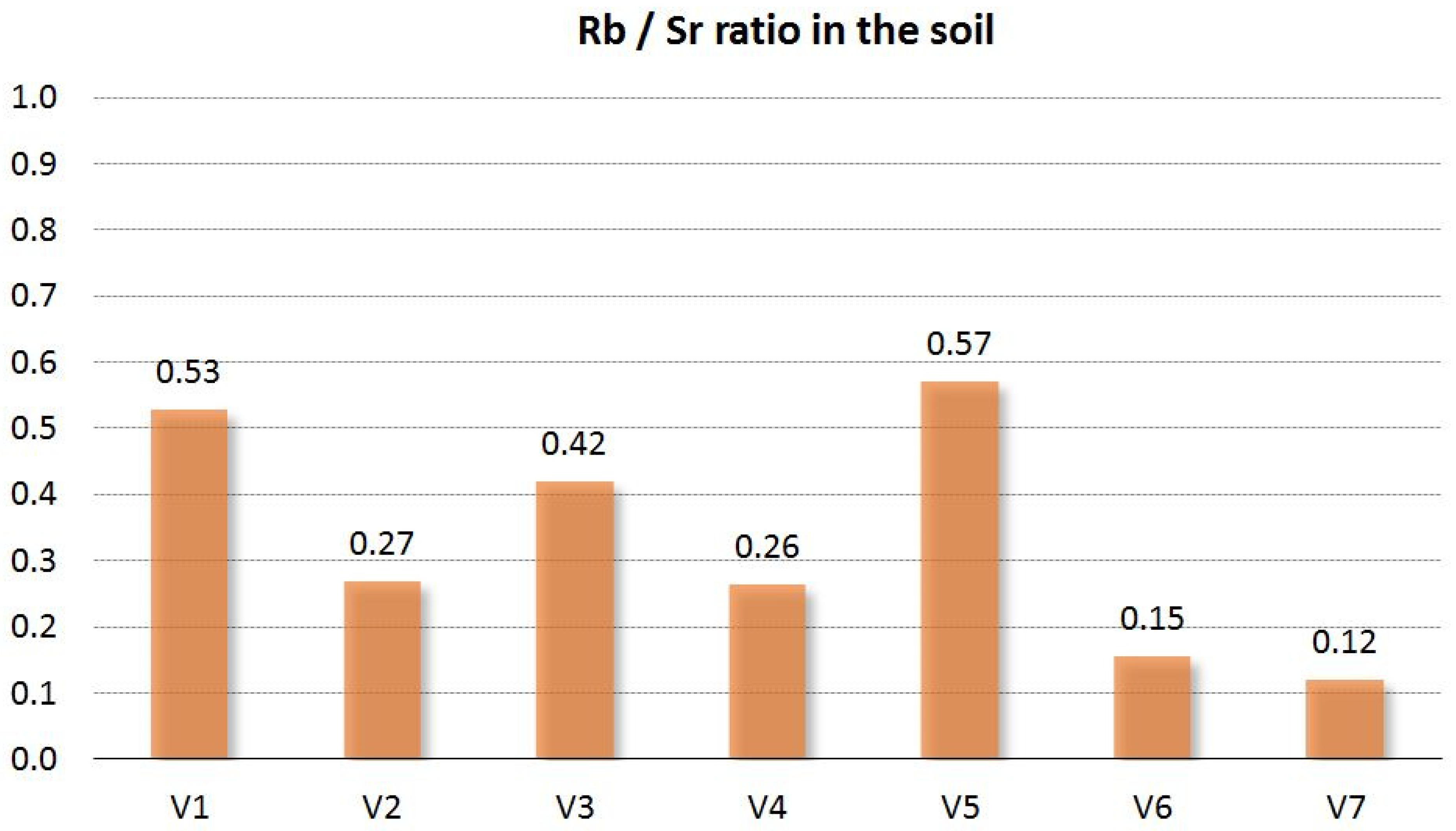

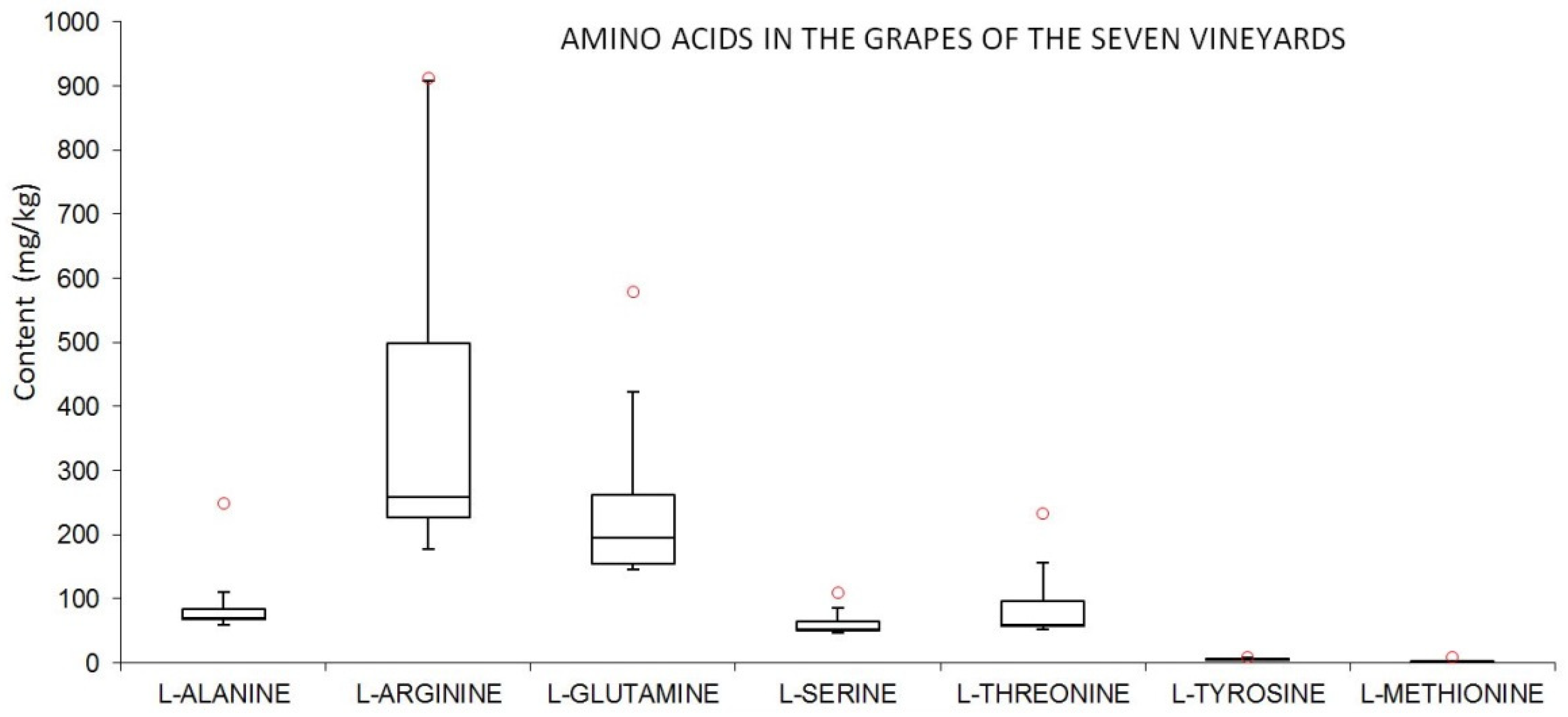
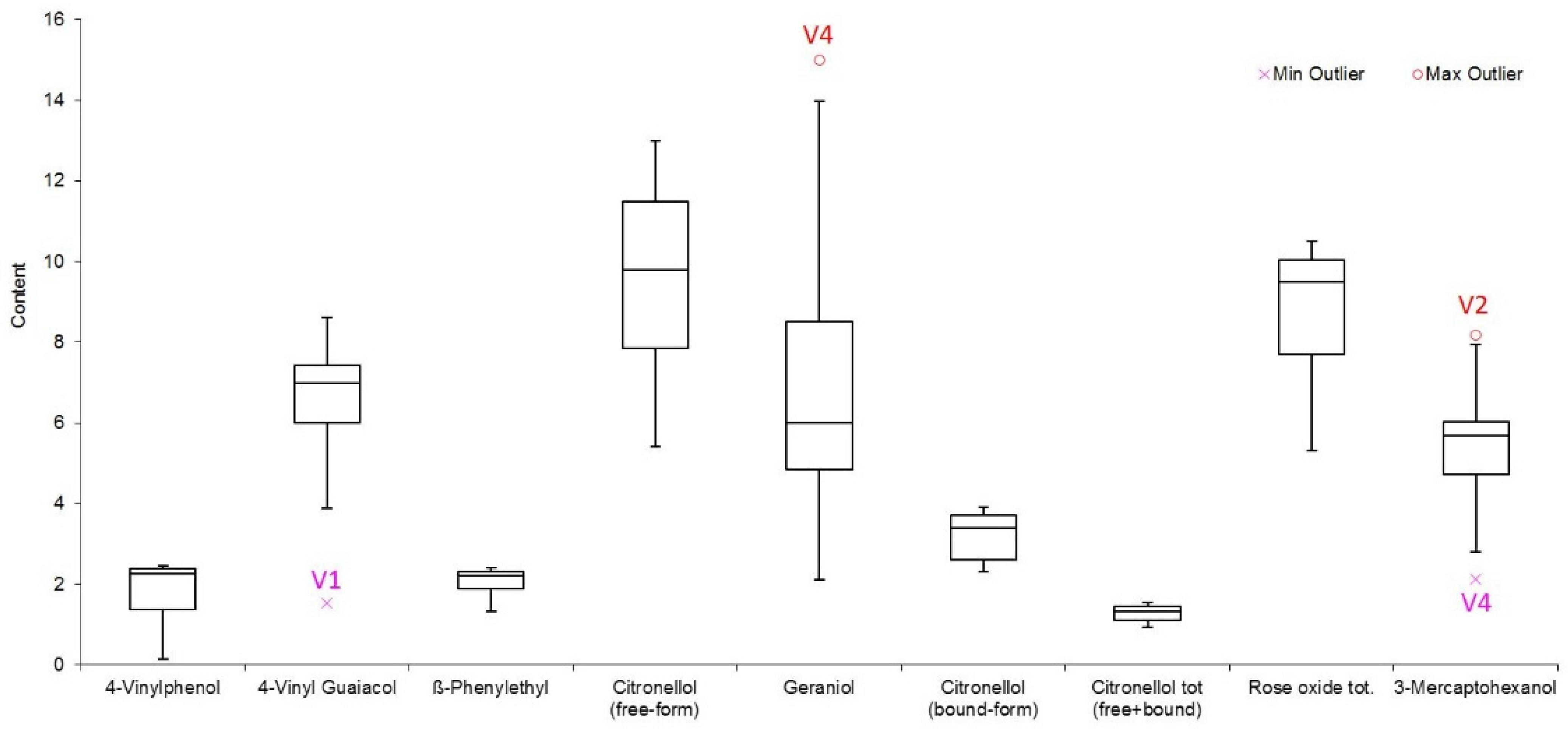
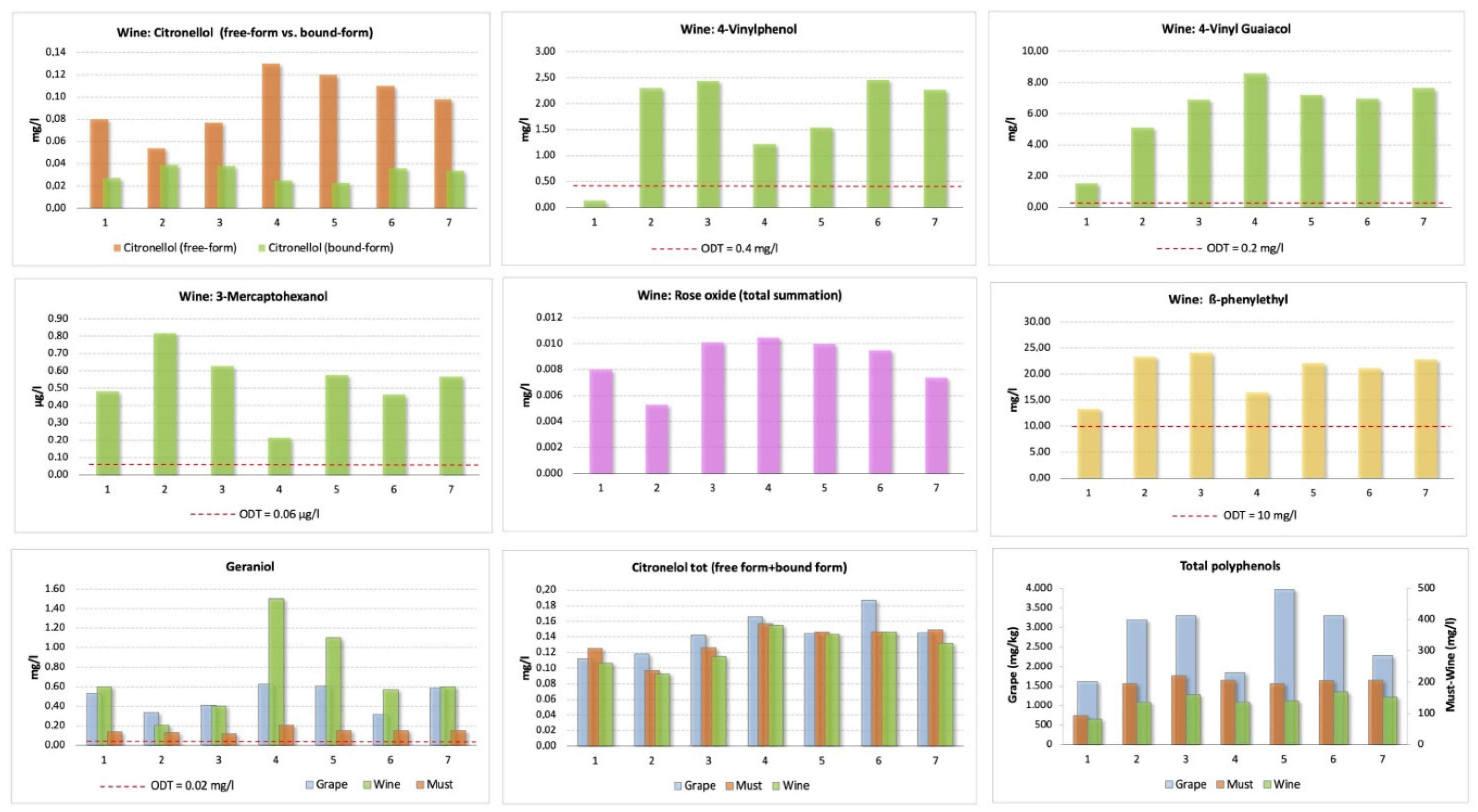

| Terroir’ Component Factor | Survey and Analysis | Measurements |
|---|---|---|
| Geology and vineyards’ geopedology (VGI method) | Geological geomorphological survey | Recognising sedimentary domains and processes in each vineyard, landscape study |
| Soil and/or subsoil | In situ stratigraphic measurement and sediment sampling of each vineyard’s stratigraphic unit/process | |
| Topoclimate (SRI method) | Vineyard’s solar radiation identity | SRI method, in situ solar radiation measurements |
| Microclimate | Multi-parameter measuring stations: air and soil in situ measurements | Air temperature, dew point, vapour pressure, humidity, rainfall, leaf wetness, wind speed and direction, soil and subsoil salinity, temperature and humidity |
| Soil sediments analysis | Laboratory tests: qualitative and quantitative analysis | GEO: mineralogy, petrography, particle size and morphological features, mineral composition, geochemistry and quantitative elementary analysis |
| AGRO: pH, texture, organic matter, cation exchange capacity, assimilable and exchangeable minerals, heavy metals, trace elements and isotope | ||
| Viticulture and wine making | Vineyard and winery practices | Kept constant for all vineyards and wines |
| Grape variety (Gewürztraminer) | Grape, must and wine targeted oenological, chemical quali–quantitative analyses | Basic chemical–physical parameters, mineral profile, amine profile, total polyphenols, flavonoid polyphenols and aroma profile, varietal compounds in free and bound forms, mineral profile, trace elements and isotope |
| Grape, must and wine untargeted oenological chemical quali–quantitative analysis | Bidimensional gas chromatography–time-of-flight mass spectrometry, liquid chromatography coupled to electrochemical detection, near-infrared spectrometry, untargeted volatilome profiles and sensory evaluation [45] |
| 1st-Cycle Sediments | 2nd-Cycle Sediments | 3rd-Cycle Sediments | |
|---|---|---|---|
| Formation periods | Throughout the Quaternary period | Glacial periods > 14,000 years B.P. | Last millennia to recent times |
| Parent material | Rocks | Rocks + remixed minerals of 1st cycle sediments | Rocks + remixed minerals of 1st- and 2nd-cycle sediments |
| Soil sediments’ parent minerals | Pure mineral selection from local parent rocks | Mixed minerals from local and distant parent rocks or sediments | Remixed materials and minerals from 2nd- cycle sediments and occasionally from local parent rocks |
| Soil’s sediment sources | Micro-catchment basin near the parent rocks | Meso- and macro-catchment basin | Micro- and meso-basins; macro-catchment basin for alluvium |
| Main sedimentary process | Weathering, debris, landslides, flash floods, debris flows, colluvial, eluvial | Glacially derived; +1st-cycle processes during the glacial periods; +paleo-fluvial and -lacustrine | 1st-and 2nd-cycle processes; +fluvial and different water–sediment flow in mountain torrents; landslides, colluvial and other gravity-driven processes |
| Locality | Vineyard | Location | Height m a.s.l. | SRI Index * |
|---|---|---|---|---|
| Söll | V1 | 46°21′40.2″ N 11°14′35.0″ E | 429 | 78.6 |
| Am Sand | None | 46°20′41.1″ N 11°15′06.8″ E | 235 | 76.3 |
| Plon | V7 | 46°19′54.3″ N 11°14′03.9″ E | 339 | 68.2 |
| Mineral Phase | V1-2 | V1-3 | V1-4 | V1-5 | V1-6 | V2-2 | V3-1 | V3-2 | V3-3 | V4-1 | V4-3 | V4-4 | V5-1 | V5-2 | V5-3 | V5-4 | V6-1 | V6-2 | V6-3 | V7-1 | V7-2 | V7-3 |
|---|---|---|---|---|---|---|---|---|---|---|---|---|---|---|---|---|---|---|---|---|---|---|
| Quartz | 36.7 | 30 | 32.1 | 38.9 | 34.1 | 21.8 | 35.4 | 38.9 | 30.4 | 19.3 | 14.6 | 31.9 | 29.8 | 24.4 | 29.9 | 31.6 | 24.9 | 19.4 | 21.4 | 38.9 | 33.1 | 40.8 |
| Muscovite | 14.4 | 19.9 | 20.9 | 20.8 | 14.4 | 5.4 | 16 | 13.8 | 17.3 | 3.6 | 4.3 | 2.5 | 7.1 | 5.6 | 4.4 | 8.3 | 7.9 | 4.5 | 5.4 | 6.3 | 7.1 | 7.8 |
| Dolomite | 20.1 | 18.6 | 12.5 | 12.6 | 11.6 | 51.4 | 16.6 | 16.2 | 23.1 | 54.8 | 51.9 | 43.3 | 37.5 | 43.6 | 35.1 | 32.7 | 40.4 | 52.3 | 36.1 | 14.6 | 17.2 | 16.6 |
| Kaolinite | 9.1 | 11 | 9.9 | 8.4 | 7.7 | 1.04 | 9.8 | 7.2 | 6.9 | 2.8 | 4.3 | 2.3 | 4.5 | 2.8 | 3.5 | 4 | 2.97 | 1.53 | 2.63 | 4 | 3.85 | 4.2 |
| Albite | 3.5 | 2.1 | 1.2 | 3 | 1.6 | 0.9 | 1.5 | 1.2 | 2.1 | 1.85 | 2.56 | 4.8 | 2.2 | 3.2 | 3.2 | 4.2 | 1.7 | 1 | 1.28 | 0.9 | 0.98 | 1.2 |
| Calcite | 2.94 | 5.56 | 7.74 | 0.61 | 8.6 | 7.38 | 4.09 | 8.15 | 6 | 5.87 | 8.21 | 1.33 | 1.1 | 2.18 | 1.53 | 0.75 | 4.21 | 12.8 | 14.8 | 17.2 | 20.4 | 10.4 |
| Orthoclase | 5.29 | 3.06 | 3.48 | 5.1 | 4.8 | 3.99 | 3.47 | 2.66 | 3.81 | 2.6 | 1.93 | 3.46 | 2.83 | 3.2 | 2.89 | 3.8 | 5.2 | 3.31 | 4.4 | 5.22 | 4.6 | 5.1 |
| Hematite | 0.34 | 0.72 | 0.36 | 0.26 | 0.18 | 0.25 | 0.29 | 0.21 | 0.38 | 0.94 | 0.1 | 0.03 | 0.11 | 0.23 | 0.01 | 0.06 | 0.34 | 0.33 | 0.37 | 0.47 | 0.49 | 0.27 |
| Clinochlore | 0.69 | 1.62 | 1.28 | 2.9 | 0.93 | 2 | 3.1 | 2 | 0.8 | 3 | 5.6 | 1.64 | 3.9 | 5.1 | 5.7 | 3.2 | 1.19 | 0.7 | 0.91 | 1.15 | 0.66 | 0.73 |
| Hornblende | 0.15 | 0 | 0.78 | 0.53 | 0.21 | 0.56 | 0.6 | |||||||||||||||
| Clay mixed layer | 7 | 7.4 | 10.6 | 7.3 | 16.1 | 5.8 | 9.8 | 9.7 | 9.1 | 5.3 | 6.6 | 8.8 | 10.1 | 9.2 | 13.6 | 10.7 | 11.2 | 4.1 | 12.3 | 11.1 | 11.6 | 13 |
| Vineyard | Texture Class | Permability | pH | SRI | Altitude (m a.s.l.) | Parent Rock (Prevalent) | Sedimentary Process | Domain | Ground Water | Soil Mineralogy ** | Mineral Markers | Chemical Markers | |
|---|---|---|---|---|---|---|---|---|---|---|---|---|---|
| NRCS-USDA | Sheppard | k (m/sec) * | (%) | ||||||||||
| 1 | loam | sandy silt | 1.2E-01 ÷ 6.3E-01 | 8.1 | 78.61 | 435.0 | Metamorphic and ancient sedimentary | Undifferentiated till deposit | Siliciclastic | no | Qz (34), Do (15), Ca (5), Phs (38) | Kaolinite Hematite | Be, B, Rb, Ag, Pb |
| 2 | silt loam | Silt-gavelly silt | 3.7E-02 ÷ 8.6E-02 | 8.4 | 75.50 | 222.4 | Dolomite | Mixed fan: stream flow | Dolomitic | no | Do (51), Qz (22), Ca (7), Phs (14) | Dolomite | Ca, CaCO3 (t), Cu |
| 3 | loam | loam | 1.0E-01 ÷ 2.5E-01 | 8.3 | 79.02 | 436.3 | Metamorphic and ancient sedimentary | Glacial lodgment till deposit | Siliciclastic | no | Qz (35), Do (19), Ca (6), Phs (35) | Kaolinite Hematite | B |
| 4 | sandy loam | sandy gravel | 2.5E-01 ÷ 4.0 | 8.4 | 76.47 | 361.7 | Dolomite | Ancient mixed fan deposit | Dolomitic | no | Do (50), Qz (22), Ca (5), Phs (17) | Dolomite Hematite | Ca, CaCO3 (t) |
| 5 | loam | silty gravel | 1.4E-02 ÷ 1.2E-01 | 8.2 | 78.29 | 315.3 | Dolomite | Ancient mixed fan deposit | Mixed | no | Do (37), Qz (29), Ca (1), Phs (25) | Hornblende Clinochlore | Ag, Mg |
| 6 | loam | silty gravel | 4.8E-02 ÷ 2.2 | 8.2 | 72.65 | 323.0 | Dolomite and ancient sedimentary | Mixed fan: stream and debris flow | Mixed | no | Do (43), Qz (22), Ca (11), Phs (18) | Ca, CaCO3 (t), Cu, Zn, S | |
| 7 | silt loam | loam | 5.7E-01 ÷ 6.6E-01 | 8.6 | 68.16 | 346.3 | Ancient sedimentary | Gravity driven deposit | Terrigenous | no | Qz (38), Do (16), Ca (16), Phs (24) | Clay mixed layerHematite, Calcite | B, Ca, CaCO3 (a), Sr |
| Variable | Unit | Mean | Standard Deviation |
|---|---|---|---|
| Barium | µg/L | 37.51 | 16.57 |
| Beryllium | µg/L | 0.19 | 0.10 |
| Boron | mg/L | 4.84 | 0.41 |
| Calcium | mg/L | 54.56 | 8.31 |
| Iron | mg/L | 0.14 | 0.05 |
| Manganese | mg/L | 0.71 | 0.36 |
| Potassium | G/L | 1.34 | 0.17 |
| Copper | mg/L | 0.13 | 0.06 |
| Rubidium | µg/L | 0.64 | 0.25 |
| Sodium | mg/L | 16.87 | 2.63 |
| Strontium | µg/L | 0.14 | 0.04 |
| Zinc | mg/L | 0.51 | 0.14 |
| Variable | Unit | Mean | Standard Deviation |
|---|---|---|---|
| L-Alanine | mg/kg | 97.21 | 67.57 |
| L-Arginine | mg/kg | 400.50 | 266.49 |
| L-Glutamine | mg/kg | 250.40 | 157.42 |
| L-Methionine | mg/kg | 1.74 | 2.83 |
| L-Serine | mg/kg | 62.07 | 22.15 |
| L-Threonine | mg/kg | 92.77 | 64.52 |
| L-Tyrosine | mg/kg | 5.56 | 1.71 |
| Variable | Unit | Mean | Standard Deviation |
|---|---|---|---|
| 4-Vinylphenol | mg/L | 1.77 | 0.87 |
| 4-Vinyl Guaiacol | mg/L | 6.29 | 2.34 |
| ß-Phenylethyl | mg/L | 20.49 | 4.04 |
| Rose oxide tot. | mg/L | 0.009 | 0.002 |
| 3-Mercaptohexanol | mg/L | 0.54 | 0.18 |
| Citronellol (free-form) | mg/L | 0.10 | 0.03 |
| Citronellol (bound-form) | mg/L | 0.03 | 0.01 |
| Citronellol tot (free + bound) | mg/L | 0.13 | 0.02 |
| Geraniol | mg/L | 0.71 | 0.44 |
| Variable | Grubbs Test Statistic (p-Value) | Dixon Test Statistic (p-Value) |
|---|---|---|
| Beryllium | 1.755 (0.144) | 0.4375 (0.194) |
| Rubidium | 2.094 (0.010) | 0.662 (0.0136) |
| L-Alanine | 2.242 (<0.001) | 0.830 (p < 0.001) |
| L-Arginine | 1.923 (0.056) | 0.453 (0.169) |
| L-Glutamine | 2.093 (0.011) | 0.592 (0.037) |
| L-Methionine | 2.249 (<0.001) | 0.888 (p < 0.001) |
| L-Serine | 2.123 (0.007) | 0.629 (0.022) |
| L-Threonine | 2.166 (0.003) | 0.740 (p < 0.001) |
| L-Tyrosine | 2.069 (0.015) | 0.596 (0.035) |
| 4-Vinyl Guaiacol | 2.027 (0.023) | 0.504 (0.103) |
| Geraniol | 0.099 (0.048) | 0.310 (0.501) |
| 3-Mercaptohexanol | 3.289 (0.023) | 0.415 (0.234) |
| Variable\Units | V1 | V2 | V3 | V4 | V5 | V6 | V7 |
|---|---|---|---|---|---|---|---|
| Beryllium | 7.00 | 1.17 | 1.00 | 1.00 | 1.00 | 1.00 | 1.00 |
| Rubidium | 12.25 | 1.00 | 1.00 | 1.33 | 1.33 | 1.00 | 1.00 |
| L-Alanine | 11.97 | 1.02 | 1.02 | 1.32 | 1.00 | 1.02 | 1.00 |
| L-Arginine | 2.07 | 1.00 | 1.00 | 1.01 | 1.06 | 1.00 | 1.00 |
| L-Glutamine | 5.89 | 1.03 | 1.07 | 2.83 | 1.01 | 1.02 | 1.07 |
| L-Methionine | 23.67 | 1.00 | 1.00 | 1.00 | 1.00 | 1.98 | 2.37 |
| L-Serine | 3.24 | 1.00 | 1.00 | 1.89 | 1.67 | 1.00 | 1.00 |
| L-Threonine | 4.05 | 1.01 | 1.00 | 1.09 | 1.00 | 1.00 | 1.00 |
| L-Tyrosine | 6.39 | 1.00 | 1.39 | 1.00 | 1.37 | 1.11 | 1.39 |
| 4-Vinyl Guaiacol | 5.95 | 2.97 | 1.00 | 2.03 | 1.15 | 1.00 | 1.00 |
| Geraniol | 1.00 | 1.65 | 1.11 | 3.09 | 2.48 | 1.00 | 1.00 |
| 3-Mercaptohexanol | 1.36 | 3.79 | 1.00 | 2.72 | 1.07 | 1.36 | 1.00 |
Publisher’s Note: MDPI stays neutral with regard to jurisdictional claims in published maps and institutional affiliations. |
© 2022 by the authors. Licensee MDPI, Basel, Switzerland. This article is an open access article distributed under the terms and conditions of the Creative Commons Attribution (CC BY) license (https://creativecommons.org/licenses/by/4.0/).
Share and Cite
Ferretti, C.G.; Febbroni, S. Terroir Traceability in Grapes, Musts and Gewürztraminer Wines from the South Tyrol Wine Region. Horticulturae 2022, 8, 586. https://doi.org/10.3390/horticulturae8070586
Ferretti CG, Febbroni S. Terroir Traceability in Grapes, Musts and Gewürztraminer Wines from the South Tyrol Wine Region. Horticulturae. 2022; 8(7):586. https://doi.org/10.3390/horticulturae8070586
Chicago/Turabian StyleFerretti, Carlo G., and Stefano Febbroni. 2022. "Terroir Traceability in Grapes, Musts and Gewürztraminer Wines from the South Tyrol Wine Region" Horticulturae 8, no. 7: 586. https://doi.org/10.3390/horticulturae8070586
APA StyleFerretti, C. G., & Febbroni, S. (2022). Terroir Traceability in Grapes, Musts and Gewürztraminer Wines from the South Tyrol Wine Region. Horticulturae, 8(7), 586. https://doi.org/10.3390/horticulturae8070586




